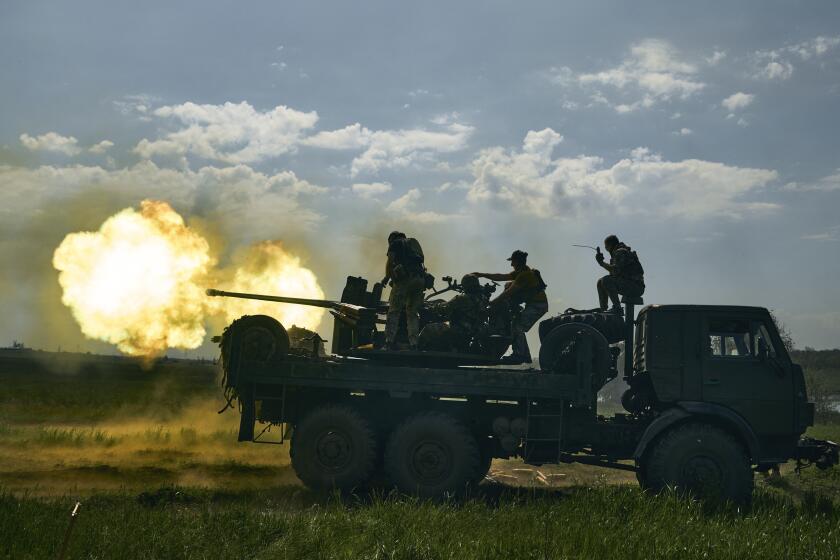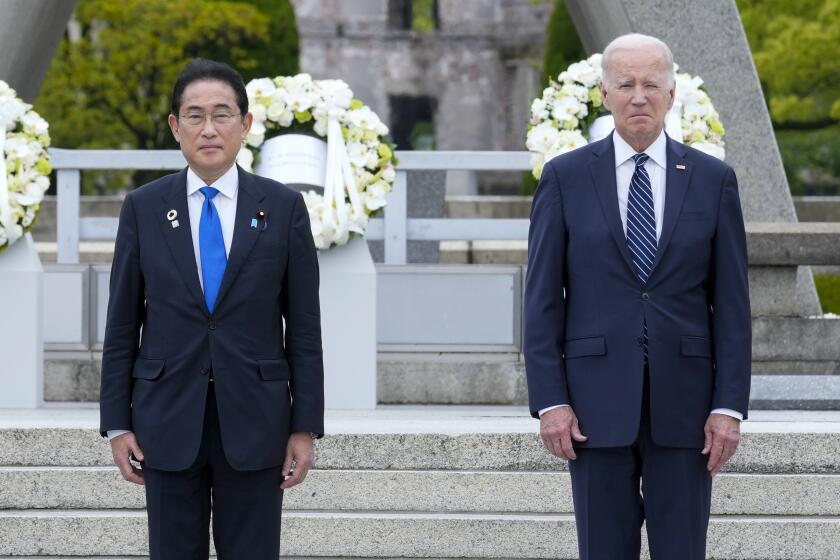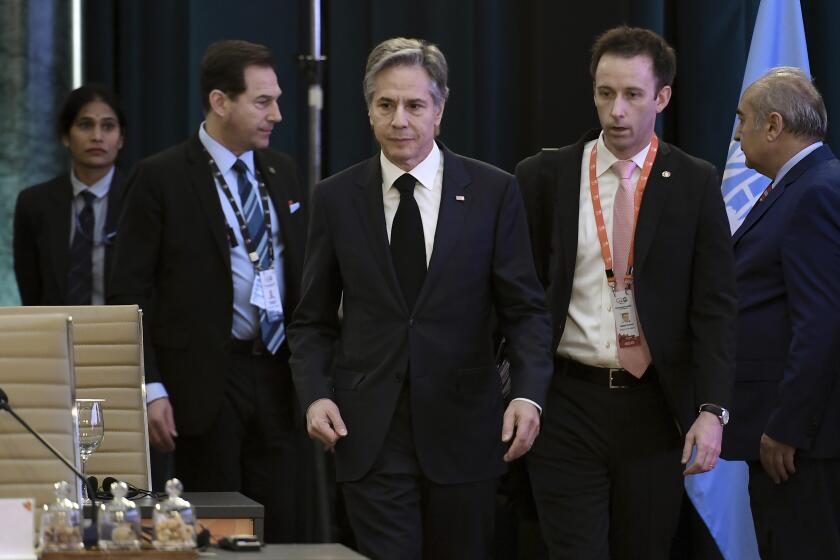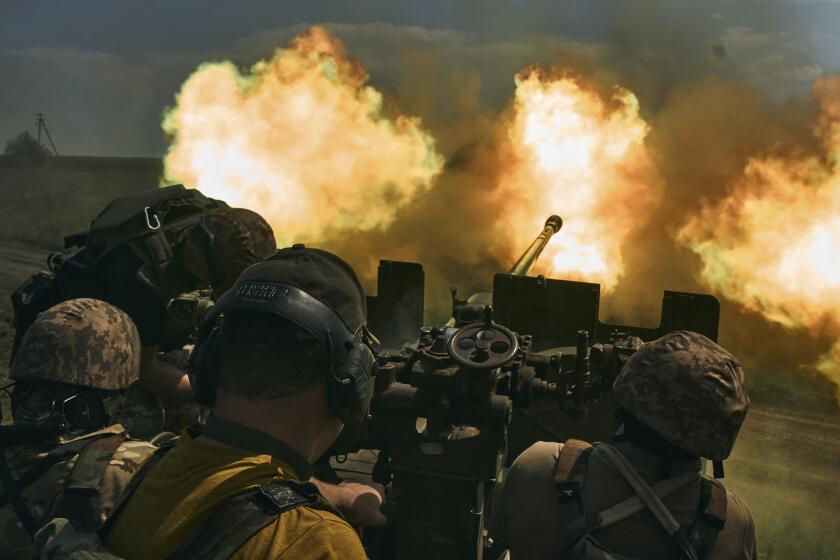Ukraine’s Zelensky arrives in Hiroshima for G-7 summit as leaders sanction Russia
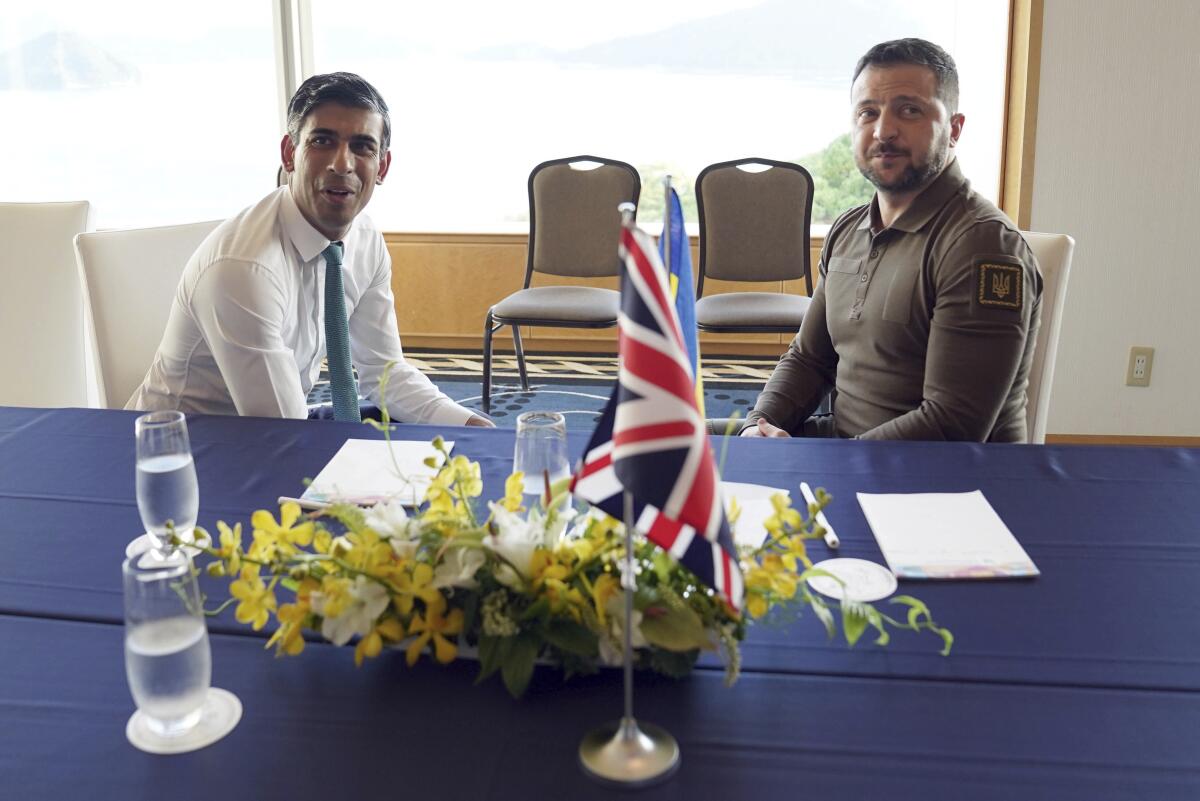
- Share via
HIROSHIMA, Japan — Ukrainian President Volodymyr Zelensky arrived Saturday in Japan for talks with the leaders of the world’s most powerful democracies, a personal appearance meant to galvanize global attention as the nations ratcheted up pressure on Moscow for its 15-month invasion of Ukraine.
Bolstering international support is a key priority as Ukraine prepares for what’s seen as a major push to take back territory seized by Russia in the war that began in February last year. Zelensky’s in-person visit to the Group of 7 summit comes just hours after the United States agreed to allow training on potent American-made fighter jets, laying the groundwork for their eventual transfer to Ukraine.
Host nation Japan said Zelensky’s inclusion stems from his “strong wish” to participate in talks with the bloc and other countries that will influence his nation’s defense against Russia.
“Japan. G7. Important meetings with partners and friends of Ukraine. Security and enhanced cooperation for our victory. Peace will become closer today,” Zelensky tweeted upon his arrival on a plane provided by France.
A European Union official, speaking on condition of anonymity to brief reporters on the deliberations, said Zelensky will take part in two separate sessions Sunday. One session will be with G-7 members only and will focus on the war in Ukraine. Another will include the G-7 as well as the other nations invited to take part in the summit, and will focus on “peace and stability.”
U.S. national security advisor Jake Sullivan said that President Biden and Zelensky would have direct engagement at the summit. On Friday, Biden announced his support for training Ukrainian pilots on U.S.-made F-16 fighter jets, a precursor to eventually providing those aircraft to Ukraine.
“It is necessary to improve [Ukraine’s] air defense capabilities, including the training of our pilots,” Zelensky wrote on his official Telegram channel after meeting Italian Prime Minister Giorgia Meloni, one of a number of leaders he talked to.
There has been talk for months of a spring counteroffensive by Ukraine to wrest back territory from Russian forces, but the drive has yet to begin.
Zelensky also met with Indian Prime Minister Narendra Modi, their first face-to-face talks since the war, and briefed him on Ukraine’s peace plan, which calls for the withdrawal of Russian troops from the country before any negotiations.
Alexander Grushko, a high-ranking Russian minister, accused Western countries of “continuing along the path of escalation,” following the announcements that raised the possibility of sending F-16s to Kyiv.
The G-7 vowed to intensify the pressure in its joint statement Saturday.
“Russia’s brutal war of aggression represents a threat to the whole world in breach of fundamental norms, rules and principles of the international community. We reaffirm our unwavering support for Ukraine for as long as it takes to bring a comprehensive, just and lasting peace,” the group said.
G-7 leaders have faced a balancing act as they look to address a raft of global worries demanding urgent attention, including climate change, artificial intelligence, poverty and economic instability, nuclear proliferation and, above all, the war in Ukraine.
China, the world’s No. 2 economy, sits at the nexus of many of those concerns.
There is increasing anxiety that Beijing, which has been steadily building up its nuclear weapons program, could try to seize Taiwan by force, sparking a wider conflict. China claims the self-governing island as its own and regularly sends ships and warplanes near it.
Group of 7 leaders convene in Hiroshima and honor victims of the U.S. atomic bomb. But they have no new plans to reduce the threat of nuclear war.
The G-7 on Saturday said it did not want to harm China and was seeking “constructive and stable relations” with Beijing, “recognizing the importance of engaging candidly with and expressing our concerns directly to China.”
It also urged China to pressure Russia to end the war in Ukraine and “support a comprehensive, just and lasting peace.”
North Korea, which has been testing missiles at a torrid pace, must completely abandon its nuclear bomb ambitions, “including any further nuclear tests or launches that use ballistic missile technology,” the leaders’ statement said.
The green light on F-16 training is the latest shift by the Biden administration as it moves to arm Ukraine with more advanced and lethal weaponry, following earlier decisions to send rocket launcher systems and Abrams tanks. The United States has insisted that it is sending weapons to Ukraine to defend itself and has discouraged attacks by Ukraine into Russian territory.
“We’ve reached a moment where it is time to look down the road again to say what is Ukraine going to need as part of a future force, to be able to deter and defend against Russian aggression as we go forward,” Sullivan said.
Decisions on the number of fourth-generation F-16 fighter jets, as well as who will provide them and when, will be made in the months ahead while training is underway, Biden told leaders.
The G-7 leaders have rolled out a new wave of global sanctions on Moscow as well as plans to enhance the effectiveness of existing financial penalties meant to constrain President Vladimir Putin’s war effort. Russia is now the most-sanctioned country in the world, but there are questions about the effectiveness.
A meeting of top diplomats of the Group of 20 industrialized and developing nations ends in New Delhi without a consensus on the war in Ukraine.
Japanese Prime Minister Fumio Kishida separately held one-on-one talks with leaders, including Modi, who is hosting the Group of 20 gathering this year.
India, the world’s largest democracy, has been measured in its comments on the war in Ukraine, and has avoided outright condemnation of Russia’s invasion. While India maintains close ties with the U.S. and its Western allies, it is also a major buyer of Russian arms and oil.
The latest sanctions aimed at Russia include tighter restrictions on already-sanctioned people and firms involved in the war effort. More than 125 individuals and organizations across 20 countries have been hit with U.S. sanctions.
The leaders began the summit with a visit to a peace park dedicated to the tens of thousands who died in the U.S. atomic bombing of Hiroshima, the world’s first nuclear attack. Kishida, who represents Hiroshima in parliament, wants nuclear disarmament to be a major focus of discussions.
The G-7 leaders also discussed efforts to strengthen the global economy and address rising prices that are squeezing families and government budgets around the world, particularly in developing countries in Africa, Asia and Latin America.
The group reiterated its aim to pull together up to $600 billion in financing for the G-7’s global infrastructure development initiative, which is meant to offer countries an alternative to China’s investment dollars.
Italian premier Meloni will skip the last day of the G-7 because of floods this week in northern Italy, which claimed at least 14 lives and devastated dozens of hamlets and towns.
The Pentagon overestimated the value of the weapons it has sent to Ukraine by at least $3 billion, freeing up more funds for additional aid to Kyiv.
Biden, who scrapped plans to travel on to Papua New Guinea and Australia after his stay in Japan so that he can get back to debt limit talks in Washington, is also meeting with leaders of the so-called Quad partnership, made up of Japan, Australia, India and the United States.
The G-7 comprises Japan, the United States, the United Kingdom, France, Germany, Canada and Italy, as well as the European Union.
Associated Press writers Zeke Miller, Elaine Kurtenbach and Mari Yamaguchi in Hiroshima, Japan, and Joanna Kozlowska in London contributed to this report.
More to Read
Sign up for Essential California
The most important California stories and recommendations in your inbox every morning.
You may occasionally receive promotional content from the Los Angeles Times.
